Twenty First Century Learning: Role of Clinical Nurse Educator
VerifiedAdded on 2023/05/31
|12
|3108
|182
Essay
AI Summary
This essay explores the importance of clinical nurse educators in promoting healthy living and effective healthcare practices in the 21st century. It highlights the shift from traditional knowledge imparting to more interactive and simulation-based learning methods. The essay reflects on the Annual Conference for Neonatal Nursing, emphasizing the significance of educating refugee communities on newborn care and sanitation. It suggests incorporating interactive sessions and feedback mechanisms to enhance learning, particularly for vulnerable populations. The document emphasizes the need for special care and treatment for refugees, considering their lack of basic education and societal challenges, advocating for a more inclusive and responsive approach to healthcare education. Desklib provides access to similar documents and study resources for students.
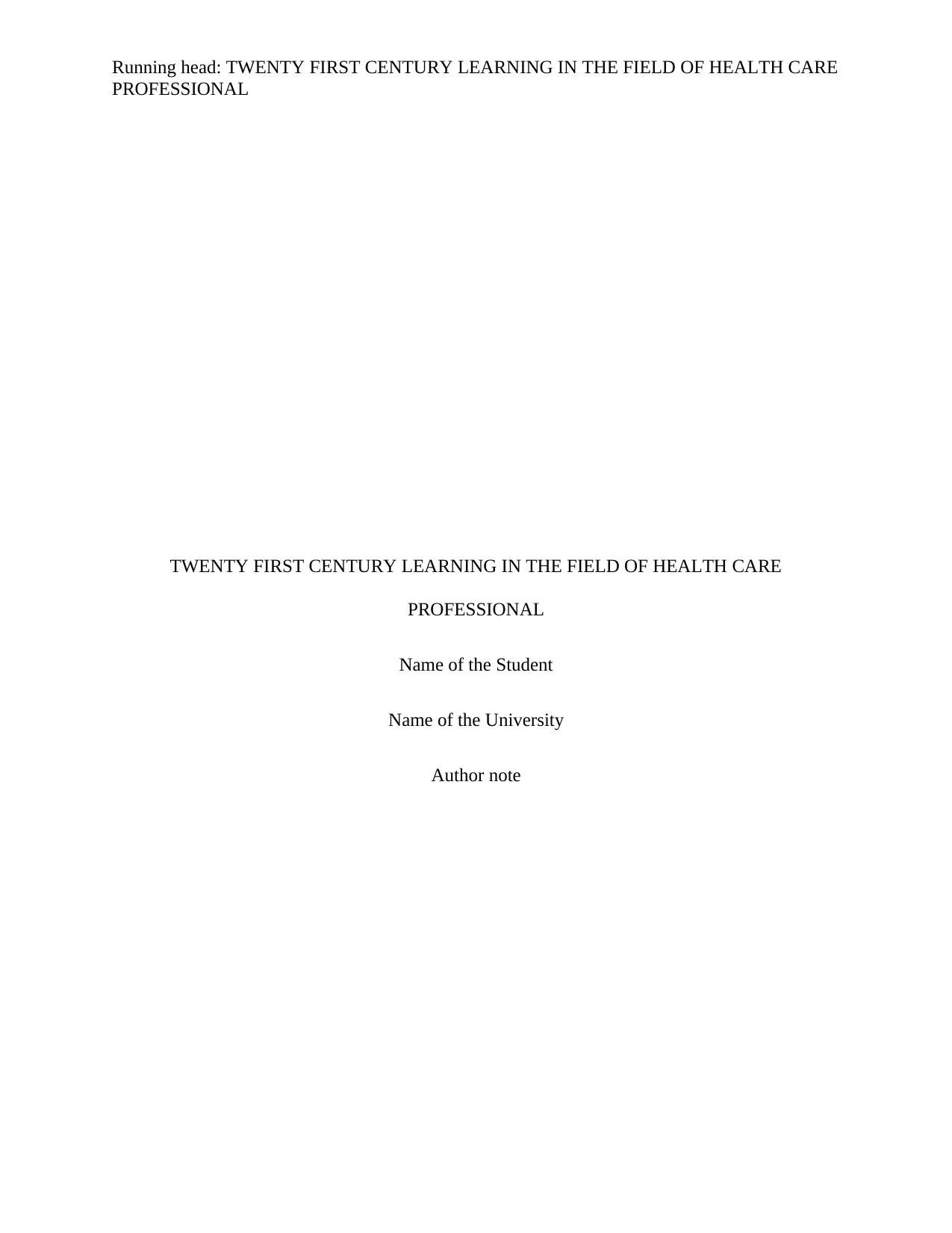
Running head: TWENTY FIRST CENTURY LEARNING IN THE FIELD OF HEALTH CARE
PROFESSIONAL
TWENTY FIRST CENTURY LEARNING IN THE FIELD OF HEALTH CARE
PROFESSIONAL
Name of the Student
Name of the University
Author note
PROFESSIONAL
TWENTY FIRST CENTURY LEARNING IN THE FIELD OF HEALTH CARE
PROFESSIONAL
Name of the Student
Name of the University
Author note
Paraphrase This Document
Need a fresh take? Get an instant paraphrase of this document with our AI Paraphraser
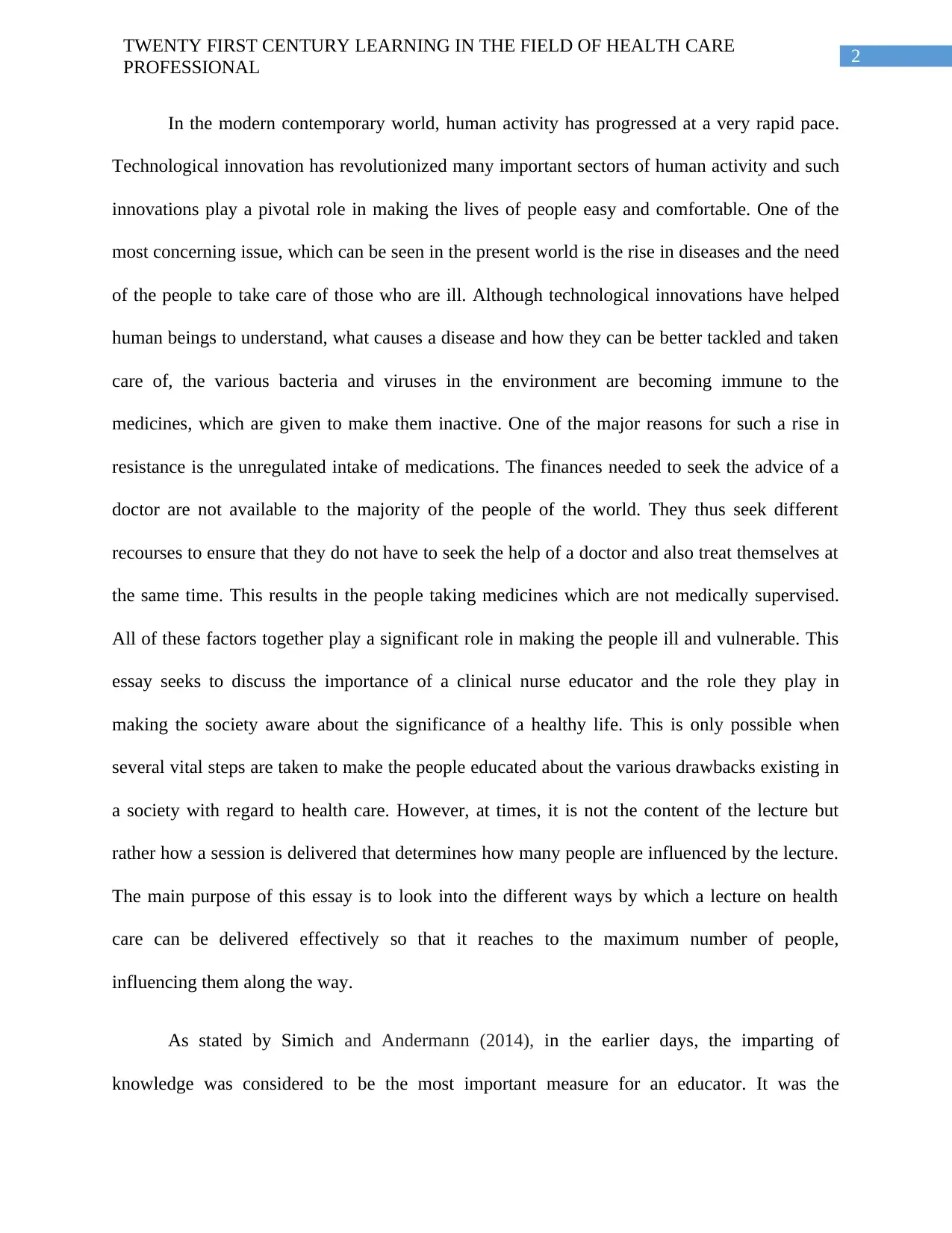
2
TWENTY FIRST CENTURY LEARNING IN THE FIELD OF HEALTH CARE
PROFESSIONAL
In the modern contemporary world, human activity has progressed at a very rapid pace.
Technological innovation has revolutionized many important sectors of human activity and such
innovations play a pivotal role in making the lives of people easy and comfortable. One of the
most concerning issue, which can be seen in the present world is the rise in diseases and the need
of the people to take care of those who are ill. Although technological innovations have helped
human beings to understand, what causes a disease and how they can be better tackled and taken
care of, the various bacteria and viruses in the environment are becoming immune to the
medicines, which are given to make them inactive. One of the major reasons for such a rise in
resistance is the unregulated intake of medications. The finances needed to seek the advice of a
doctor are not available to the majority of the people of the world. They thus seek different
recourses to ensure that they do not have to seek the help of a doctor and also treat themselves at
the same time. This results in the people taking medicines which are not medically supervised.
All of these factors together play a significant role in making the people ill and vulnerable. This
essay seeks to discuss the importance of a clinical nurse educator and the role they play in
making the society aware about the significance of a healthy life. This is only possible when
several vital steps are taken to make the people educated about the various drawbacks existing in
a society with regard to health care. However, at times, it is not the content of the lecture but
rather how a session is delivered that determines how many people are influenced by the lecture.
The main purpose of this essay is to look into the different ways by which a lecture on health
care can be delivered effectively so that it reaches to the maximum number of people,
influencing them along the way.
As stated by Simich and Andermann (2014), in the earlier days, the imparting of
knowledge was considered to be the most important measure for an educator. It was the
TWENTY FIRST CENTURY LEARNING IN THE FIELD OF HEALTH CARE
PROFESSIONAL
In the modern contemporary world, human activity has progressed at a very rapid pace.
Technological innovation has revolutionized many important sectors of human activity and such
innovations play a pivotal role in making the lives of people easy and comfortable. One of the
most concerning issue, which can be seen in the present world is the rise in diseases and the need
of the people to take care of those who are ill. Although technological innovations have helped
human beings to understand, what causes a disease and how they can be better tackled and taken
care of, the various bacteria and viruses in the environment are becoming immune to the
medicines, which are given to make them inactive. One of the major reasons for such a rise in
resistance is the unregulated intake of medications. The finances needed to seek the advice of a
doctor are not available to the majority of the people of the world. They thus seek different
recourses to ensure that they do not have to seek the help of a doctor and also treat themselves at
the same time. This results in the people taking medicines which are not medically supervised.
All of these factors together play a significant role in making the people ill and vulnerable. This
essay seeks to discuss the importance of a clinical nurse educator and the role they play in
making the society aware about the significance of a healthy life. This is only possible when
several vital steps are taken to make the people educated about the various drawbacks existing in
a society with regard to health care. However, at times, it is not the content of the lecture but
rather how a session is delivered that determines how many people are influenced by the lecture.
The main purpose of this essay is to look into the different ways by which a lecture on health
care can be delivered effectively so that it reaches to the maximum number of people,
influencing them along the way.
As stated by Simich and Andermann (2014), in the earlier days, the imparting of
knowledge was considered to be the most important measure for an educator. It was the
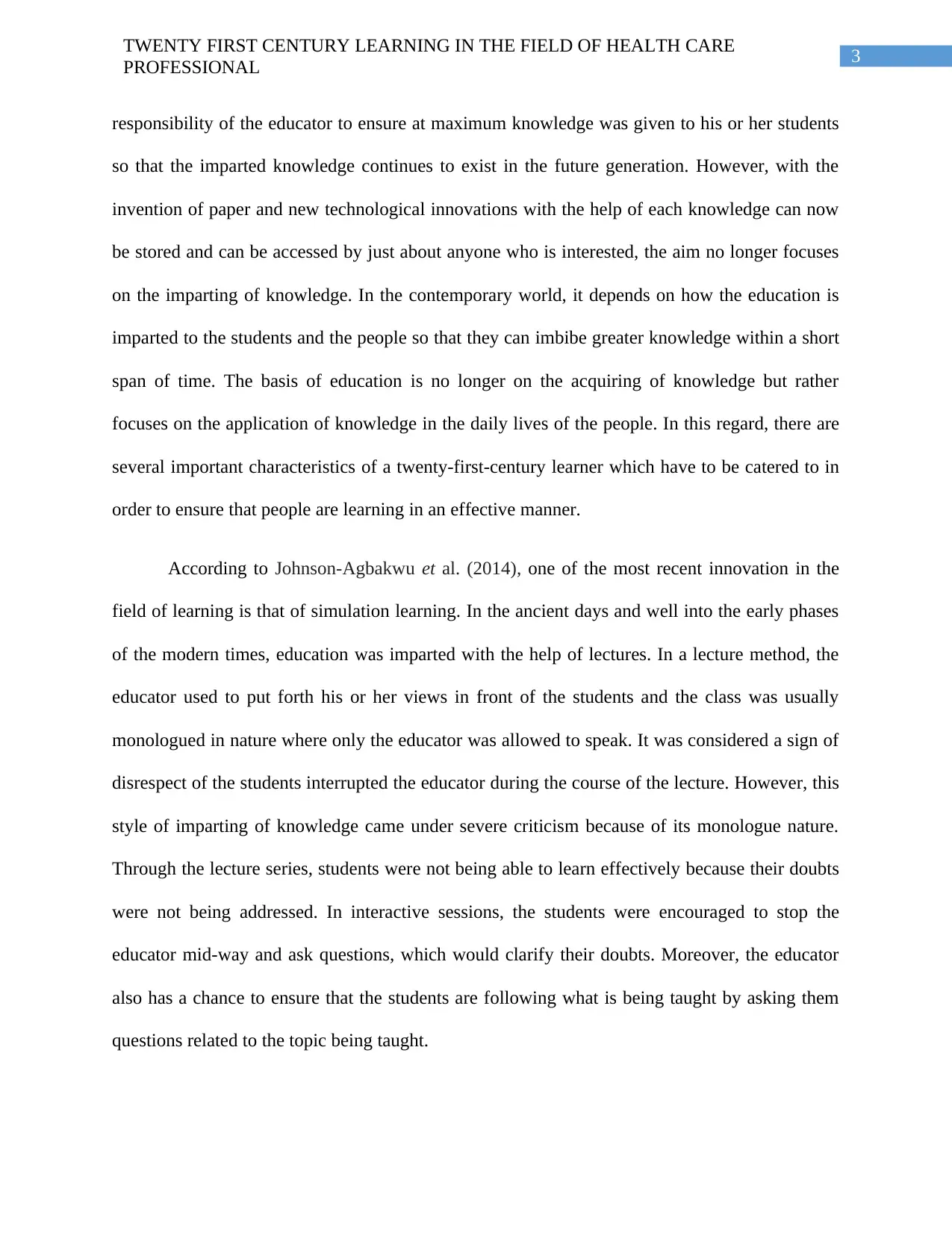
3
TWENTY FIRST CENTURY LEARNING IN THE FIELD OF HEALTH CARE
PROFESSIONAL
responsibility of the educator to ensure at maximum knowledge was given to his or her students
so that the imparted knowledge continues to exist in the future generation. However, with the
invention of paper and new technological innovations with the help of each knowledge can now
be stored and can be accessed by just about anyone who is interested, the aim no longer focuses
on the imparting of knowledge. In the contemporary world, it depends on how the education is
imparted to the students and the people so that they can imbibe greater knowledge within a short
span of time. The basis of education is no longer on the acquiring of knowledge but rather
focuses on the application of knowledge in the daily lives of the people. In this regard, there are
several important characteristics of a twenty-first-century learner which have to be catered to in
order to ensure that people are learning in an effective manner.
According to Johnson-Agbakwu et al. (2014), one of the most recent innovation in the
field of learning is that of simulation learning. In the ancient days and well into the early phases
of the modern times, education was imparted with the help of lectures. In a lecture method, the
educator used to put forth his or her views in front of the students and the class was usually
monologued in nature where only the educator was allowed to speak. It was considered a sign of
disrespect of the students interrupted the educator during the course of the lecture. However, this
style of imparting of knowledge came under severe criticism because of its monologue nature.
Through the lecture series, students were not being able to learn effectively because their doubts
were not being addressed. In interactive sessions, the students were encouraged to stop the
educator mid-way and ask questions, which would clarify their doubts. Moreover, the educator
also has a chance to ensure that the students are following what is being taught by asking them
questions related to the topic being taught.
TWENTY FIRST CENTURY LEARNING IN THE FIELD OF HEALTH CARE
PROFESSIONAL
responsibility of the educator to ensure at maximum knowledge was given to his or her students
so that the imparted knowledge continues to exist in the future generation. However, with the
invention of paper and new technological innovations with the help of each knowledge can now
be stored and can be accessed by just about anyone who is interested, the aim no longer focuses
on the imparting of knowledge. In the contemporary world, it depends on how the education is
imparted to the students and the people so that they can imbibe greater knowledge within a short
span of time. The basis of education is no longer on the acquiring of knowledge but rather
focuses on the application of knowledge in the daily lives of the people. In this regard, there are
several important characteristics of a twenty-first-century learner which have to be catered to in
order to ensure that people are learning in an effective manner.
According to Johnson-Agbakwu et al. (2014), one of the most recent innovation in the
field of learning is that of simulation learning. In the ancient days and well into the early phases
of the modern times, education was imparted with the help of lectures. In a lecture method, the
educator used to put forth his or her views in front of the students and the class was usually
monologued in nature where only the educator was allowed to speak. It was considered a sign of
disrespect of the students interrupted the educator during the course of the lecture. However, this
style of imparting of knowledge came under severe criticism because of its monologue nature.
Through the lecture series, students were not being able to learn effectively because their doubts
were not being addressed. In interactive sessions, the students were encouraged to stop the
educator mid-way and ask questions, which would clarify their doubts. Moreover, the educator
also has a chance to ensure that the students are following what is being taught by asking them
questions related to the topic being taught.
⊘ This is a preview!⊘
Do you want full access?
Subscribe today to unlock all pages.

Trusted by 1+ million students worldwide
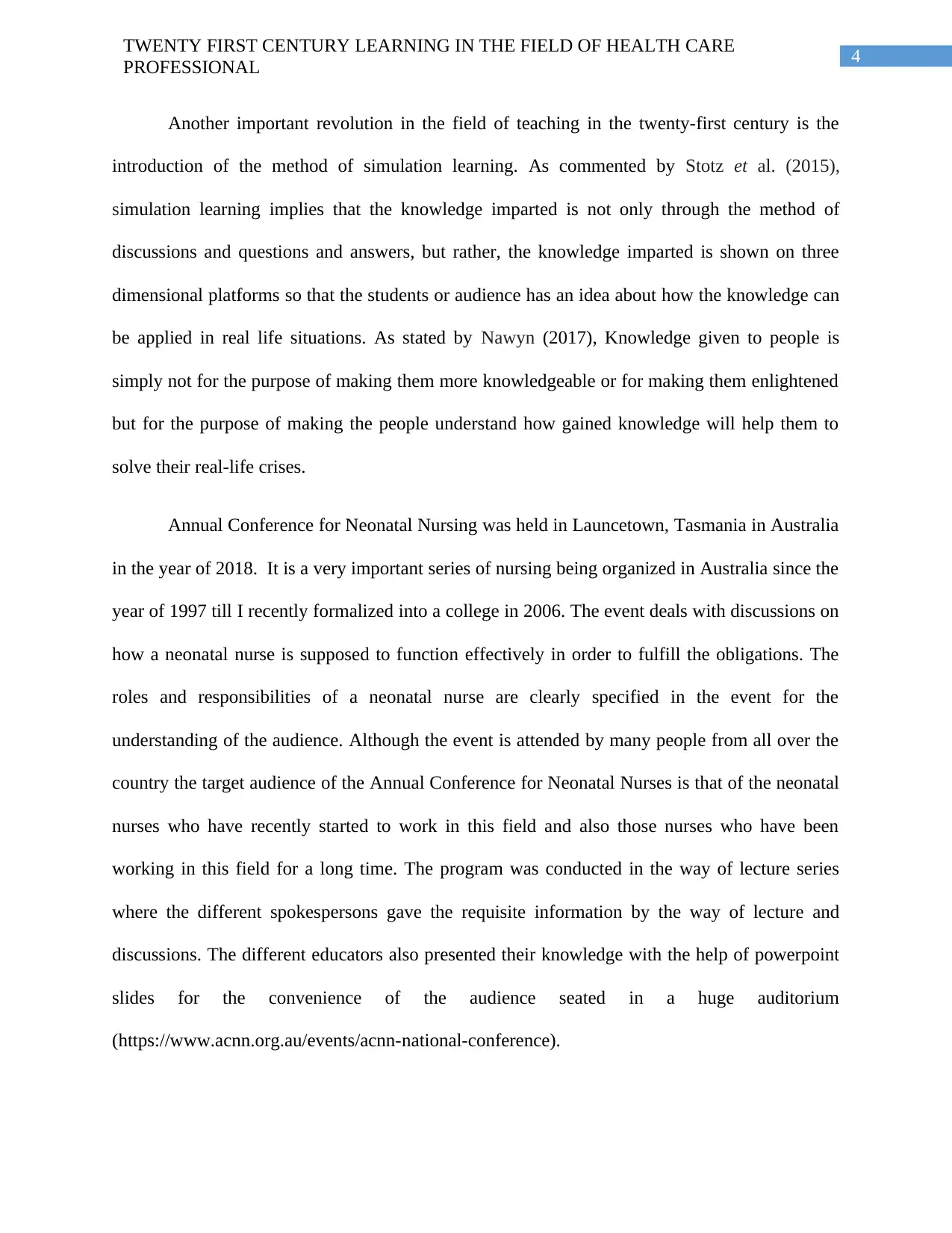
4
TWENTY FIRST CENTURY LEARNING IN THE FIELD OF HEALTH CARE
PROFESSIONAL
Another important revolution in the field of teaching in the twenty-first century is the
introduction of the method of simulation learning. As commented by Stotz et al. (2015),
simulation learning implies that the knowledge imparted is not only through the method of
discussions and questions and answers, but rather, the knowledge imparted is shown on three
dimensional platforms so that the students or audience has an idea about how the knowledge can
be applied in real life situations. As stated by Nawyn (2017), Knowledge given to people is
simply not for the purpose of making them more knowledgeable or for making them enlightened
but for the purpose of making the people understand how gained knowledge will help them to
solve their real-life crises.
Annual Conference for Neonatal Nursing was held in Launcetown, Tasmania in Australia
in the year of 2018. It is a very important series of nursing being organized in Australia since the
year of 1997 till I recently formalized into a college in 2006. The event deals with discussions on
how a neonatal nurse is supposed to function effectively in order to fulfill the obligations. The
roles and responsibilities of a neonatal nurse are clearly specified in the event for the
understanding of the audience. Although the event is attended by many people from all over the
country the target audience of the Annual Conference for Neonatal Nurses is that of the neonatal
nurses who have recently started to work in this field and also those nurses who have been
working in this field for a long time. The program was conducted in the way of lecture series
where the different spokespersons gave the requisite information by the way of lecture and
discussions. The different educators also presented their knowledge with the help of powerpoint
slides for the convenience of the audience seated in a huge auditorium
(https://www.acnn.org.au/events/acnn-national-conference).
TWENTY FIRST CENTURY LEARNING IN THE FIELD OF HEALTH CARE
PROFESSIONAL
Another important revolution in the field of teaching in the twenty-first century is the
introduction of the method of simulation learning. As commented by Stotz et al. (2015),
simulation learning implies that the knowledge imparted is not only through the method of
discussions and questions and answers, but rather, the knowledge imparted is shown on three
dimensional platforms so that the students or audience has an idea about how the knowledge can
be applied in real life situations. As stated by Nawyn (2017), Knowledge given to people is
simply not for the purpose of making them more knowledgeable or for making them enlightened
but for the purpose of making the people understand how gained knowledge will help them to
solve their real-life crises.
Annual Conference for Neonatal Nursing was held in Launcetown, Tasmania in Australia
in the year of 2018. It is a very important series of nursing being organized in Australia since the
year of 1997 till I recently formalized into a college in 2006. The event deals with discussions on
how a neonatal nurse is supposed to function effectively in order to fulfill the obligations. The
roles and responsibilities of a neonatal nurse are clearly specified in the event for the
understanding of the audience. Although the event is attended by many people from all over the
country the target audience of the Annual Conference for Neonatal Nurses is that of the neonatal
nurses who have recently started to work in this field and also those nurses who have been
working in this field for a long time. The program was conducted in the way of lecture series
where the different spokespersons gave the requisite information by the way of lecture and
discussions. The different educators also presented their knowledge with the help of powerpoint
slides for the convenience of the audience seated in a huge auditorium
(https://www.acnn.org.au/events/acnn-national-conference).
Paraphrase This Document
Need a fresh take? Get an instant paraphrase of this document with our AI Paraphraser
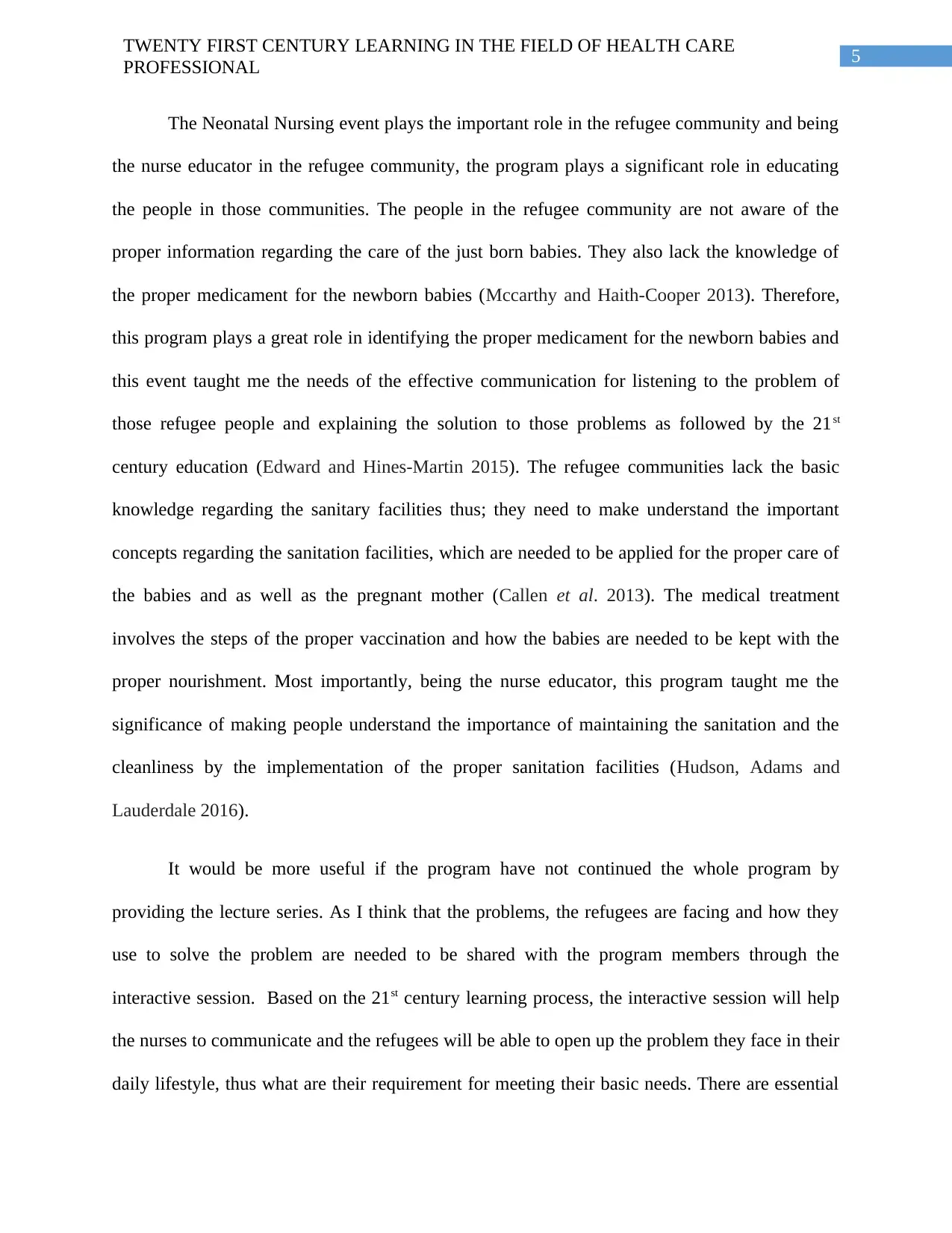
5
TWENTY FIRST CENTURY LEARNING IN THE FIELD OF HEALTH CARE
PROFESSIONAL
The Neonatal Nursing event plays the important role in the refugee community and being
the nurse educator in the refugee community, the program plays a significant role in educating
the people in those communities. The people in the refugee community are not aware of the
proper information regarding the care of the just born babies. They also lack the knowledge of
the proper medicament for the newborn babies (Mccarthy and Haith-Cooper 2013). Therefore,
this program plays a great role in identifying the proper medicament for the newborn babies and
this event taught me the needs of the effective communication for listening to the problem of
those refugee people and explaining the solution to those problems as followed by the 21st
century education (Edward and Hines-Martin 2015). The refugee communities lack the basic
knowledge regarding the sanitary facilities thus; they need to make understand the important
concepts regarding the sanitation facilities, which are needed to be applied for the proper care of
the babies and as well as the pregnant mother (Callen et al. 2013). The medical treatment
involves the steps of the proper vaccination and how the babies are needed to be kept with the
proper nourishment. Most importantly, being the nurse educator, this program taught me the
significance of making people understand the importance of maintaining the sanitation and the
cleanliness by the implementation of the proper sanitation facilities (Hudson, Adams and
Lauderdale 2016).
It would be more useful if the program have not continued the whole program by
providing the lecture series. As I think that the problems, the refugees are facing and how they
use to solve the problem are needed to be shared with the program members through the
interactive session. Based on the 21st century learning process, the interactive session will help
the nurses to communicate and the refugees will be able to open up the problem they face in their
daily lifestyle, thus what are their requirement for meeting their basic needs. There are essential
TWENTY FIRST CENTURY LEARNING IN THE FIELD OF HEALTH CARE
PROFESSIONAL
The Neonatal Nursing event plays the important role in the refugee community and being
the nurse educator in the refugee community, the program plays a significant role in educating
the people in those communities. The people in the refugee community are not aware of the
proper information regarding the care of the just born babies. They also lack the knowledge of
the proper medicament for the newborn babies (Mccarthy and Haith-Cooper 2013). Therefore,
this program plays a great role in identifying the proper medicament for the newborn babies and
this event taught me the needs of the effective communication for listening to the problem of
those refugee people and explaining the solution to those problems as followed by the 21st
century education (Edward and Hines-Martin 2015). The refugee communities lack the basic
knowledge regarding the sanitary facilities thus; they need to make understand the important
concepts regarding the sanitation facilities, which are needed to be applied for the proper care of
the babies and as well as the pregnant mother (Callen et al. 2013). The medical treatment
involves the steps of the proper vaccination and how the babies are needed to be kept with the
proper nourishment. Most importantly, being the nurse educator, this program taught me the
significance of making people understand the importance of maintaining the sanitation and the
cleanliness by the implementation of the proper sanitation facilities (Hudson, Adams and
Lauderdale 2016).
It would be more useful if the program have not continued the whole program by
providing the lecture series. As I think that the problems, the refugees are facing and how they
use to solve the problem are needed to be shared with the program members through the
interactive session. Based on the 21st century learning process, the interactive session will help
the nurses to communicate and the refugees will be able to open up the problem they face in their
daily lifestyle, thus what are their requirement for meeting their basic needs. There are essential
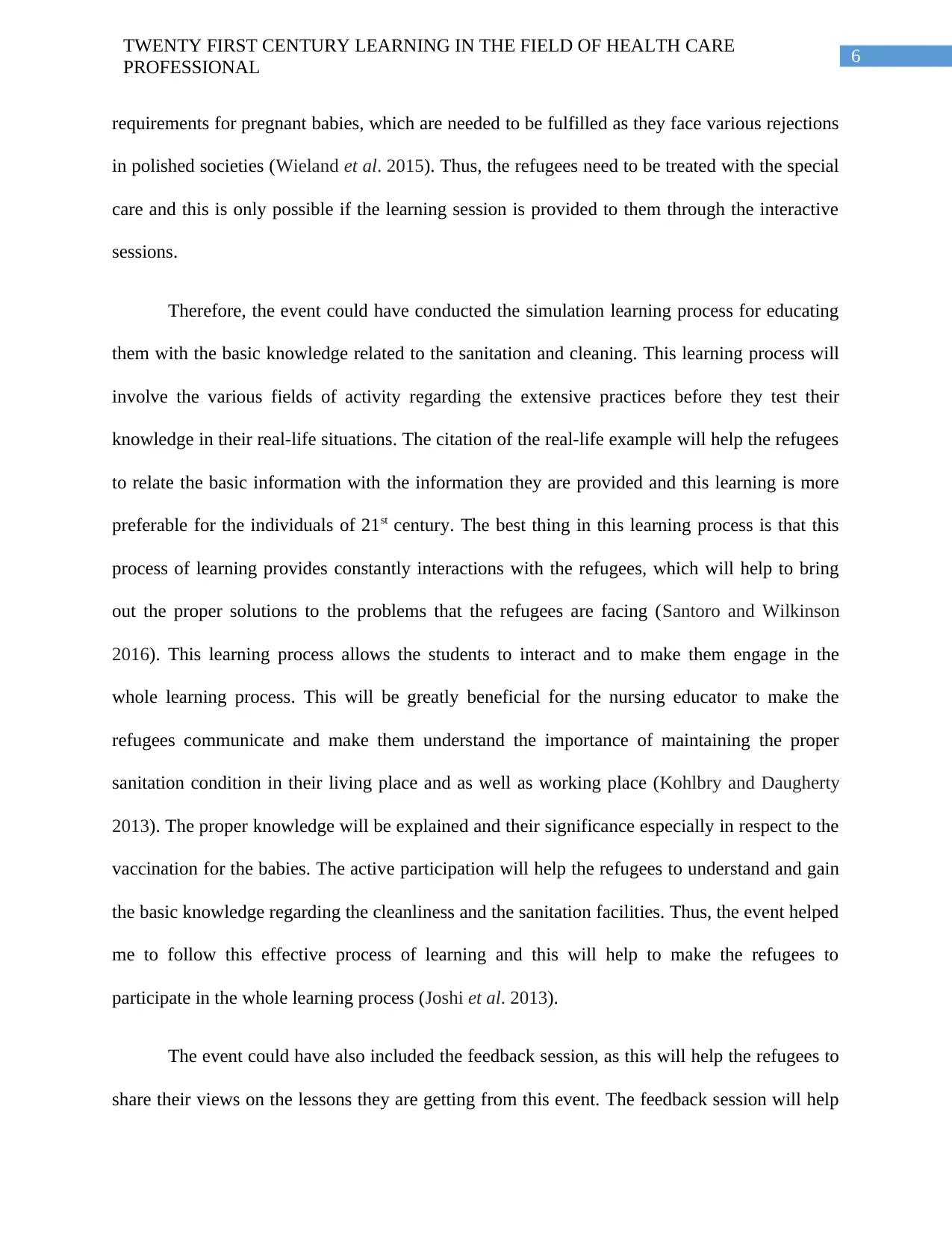
6
TWENTY FIRST CENTURY LEARNING IN THE FIELD OF HEALTH CARE
PROFESSIONAL
requirements for pregnant babies, which are needed to be fulfilled as they face various rejections
in polished societies (Wieland et al. 2015). Thus, the refugees need to be treated with the special
care and this is only possible if the learning session is provided to them through the interactive
sessions.
Therefore, the event could have conducted the simulation learning process for educating
them with the basic knowledge related to the sanitation and cleaning. This learning process will
involve the various fields of activity regarding the extensive practices before they test their
knowledge in their real-life situations. The citation of the real-life example will help the refugees
to relate the basic information with the information they are provided and this learning is more
preferable for the individuals of 21st century. The best thing in this learning process is that this
process of learning provides constantly interactions with the refugees, which will help to bring
out the proper solutions to the problems that the refugees are facing (Santoro and Wilkinson
2016). This learning process allows the students to interact and to make them engage in the
whole learning process. This will be greatly beneficial for the nursing educator to make the
refugees communicate and make them understand the importance of maintaining the proper
sanitation condition in their living place and as well as working place (Kohlbry and Daugherty
2013). The proper knowledge will be explained and their significance especially in respect to the
vaccination for the babies. The active participation will help the refugees to understand and gain
the basic knowledge regarding the cleanliness and the sanitation facilities. Thus, the event helped
me to follow this effective process of learning and this will help to make the refugees to
participate in the whole learning process (Joshi et al. 2013).
The event could have also included the feedback session, as this will help the refugees to
share their views on the lessons they are getting from this event. The feedback session will help
TWENTY FIRST CENTURY LEARNING IN THE FIELD OF HEALTH CARE
PROFESSIONAL
requirements for pregnant babies, which are needed to be fulfilled as they face various rejections
in polished societies (Wieland et al. 2015). Thus, the refugees need to be treated with the special
care and this is only possible if the learning session is provided to them through the interactive
sessions.
Therefore, the event could have conducted the simulation learning process for educating
them with the basic knowledge related to the sanitation and cleaning. This learning process will
involve the various fields of activity regarding the extensive practices before they test their
knowledge in their real-life situations. The citation of the real-life example will help the refugees
to relate the basic information with the information they are provided and this learning is more
preferable for the individuals of 21st century. The best thing in this learning process is that this
process of learning provides constantly interactions with the refugees, which will help to bring
out the proper solutions to the problems that the refugees are facing (Santoro and Wilkinson
2016). This learning process allows the students to interact and to make them engage in the
whole learning process. This will be greatly beneficial for the nursing educator to make the
refugees communicate and make them understand the importance of maintaining the proper
sanitation condition in their living place and as well as working place (Kohlbry and Daugherty
2013). The proper knowledge will be explained and their significance especially in respect to the
vaccination for the babies. The active participation will help the refugees to understand and gain
the basic knowledge regarding the cleanliness and the sanitation facilities. Thus, the event helped
me to follow this effective process of learning and this will help to make the refugees to
participate in the whole learning process (Joshi et al. 2013).
The event could have also included the feedback session, as this will help the refugees to
share their views on the lessons they are getting from this event. The feedback session will help
⊘ This is a preview!⊘
Do you want full access?
Subscribe today to unlock all pages.

Trusted by 1+ million students worldwide
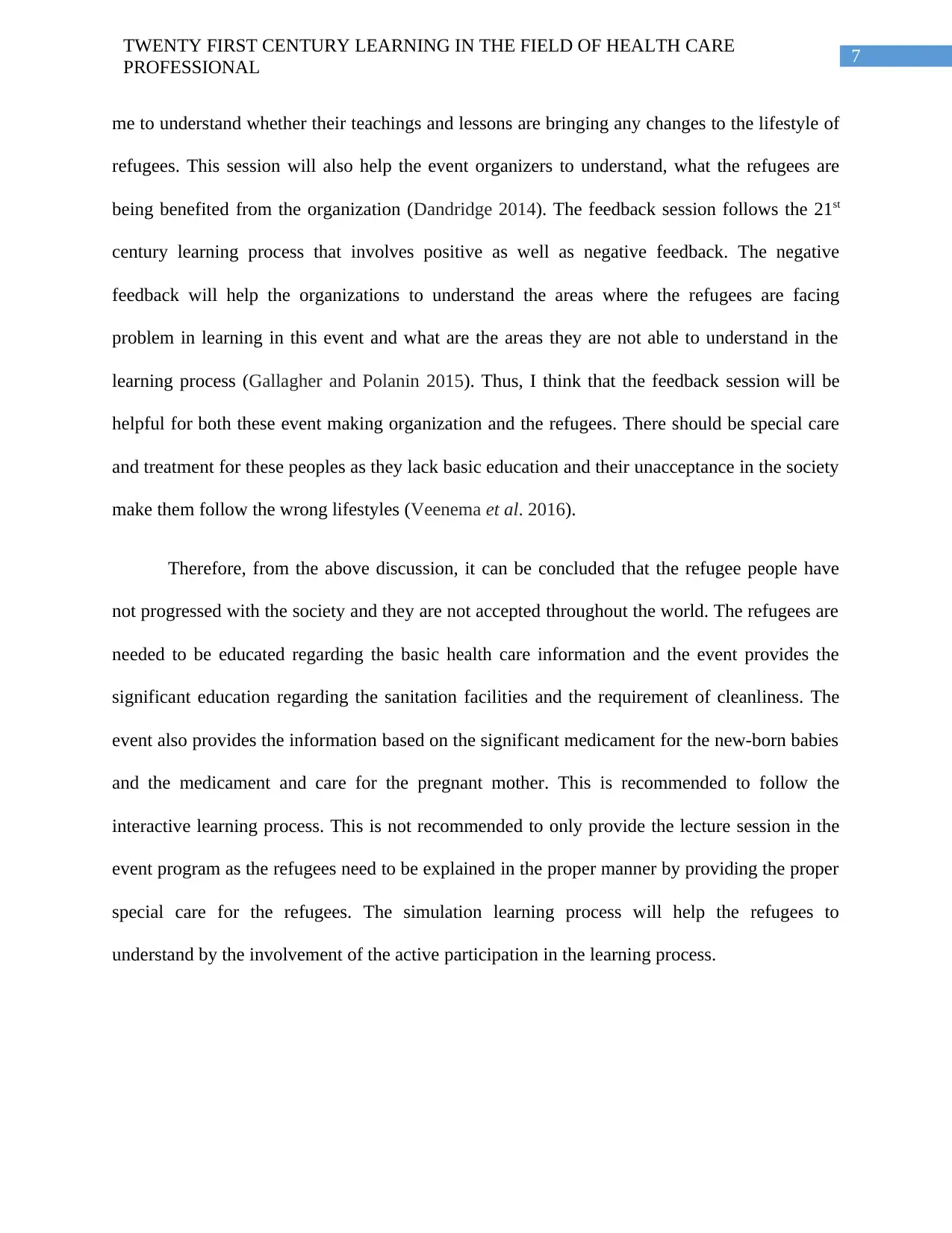
7
TWENTY FIRST CENTURY LEARNING IN THE FIELD OF HEALTH CARE
PROFESSIONAL
me to understand whether their teachings and lessons are bringing any changes to the lifestyle of
refugees. This session will also help the event organizers to understand, what the refugees are
being benefited from the organization (Dandridge 2014). The feedback session follows the 21st
century learning process that involves positive as well as negative feedback. The negative
feedback will help the organizations to understand the areas where the refugees are facing
problem in learning in this event and what are the areas they are not able to understand in the
learning process (Gallagher and Polanin 2015). Thus, I think that the feedback session will be
helpful for both these event making organization and the refugees. There should be special care
and treatment for these peoples as they lack basic education and their unacceptance in the society
make them follow the wrong lifestyles (Veenema et al. 2016).
Therefore, from the above discussion, it can be concluded that the refugee people have
not progressed with the society and they are not accepted throughout the world. The refugees are
needed to be educated regarding the basic health care information and the event provides the
significant education regarding the sanitation facilities and the requirement of cleanliness. The
event also provides the information based on the significant medicament for the new-born babies
and the medicament and care for the pregnant mother. This is recommended to follow the
interactive learning process. This is not recommended to only provide the lecture session in the
event program as the refugees need to be explained in the proper manner by providing the proper
special care for the refugees. The simulation learning process will help the refugees to
understand by the involvement of the active participation in the learning process.
TWENTY FIRST CENTURY LEARNING IN THE FIELD OF HEALTH CARE
PROFESSIONAL
me to understand whether their teachings and lessons are bringing any changes to the lifestyle of
refugees. This session will also help the event organizers to understand, what the refugees are
being benefited from the organization (Dandridge 2014). The feedback session follows the 21st
century learning process that involves positive as well as negative feedback. The negative
feedback will help the organizations to understand the areas where the refugees are facing
problem in learning in this event and what are the areas they are not able to understand in the
learning process (Gallagher and Polanin 2015). Thus, I think that the feedback session will be
helpful for both these event making organization and the refugees. There should be special care
and treatment for these peoples as they lack basic education and their unacceptance in the society
make them follow the wrong lifestyles (Veenema et al. 2016).
Therefore, from the above discussion, it can be concluded that the refugee people have
not progressed with the society and they are not accepted throughout the world. The refugees are
needed to be educated regarding the basic health care information and the event provides the
significant education regarding the sanitation facilities and the requirement of cleanliness. The
event also provides the information based on the significant medicament for the new-born babies
and the medicament and care for the pregnant mother. This is recommended to follow the
interactive learning process. This is not recommended to only provide the lecture session in the
event program as the refugees need to be explained in the proper manner by providing the proper
special care for the refugees. The simulation learning process will help the refugees to
understand by the involvement of the active participation in the learning process.
Paraphrase This Document
Need a fresh take? Get an instant paraphrase of this document with our AI Paraphraser
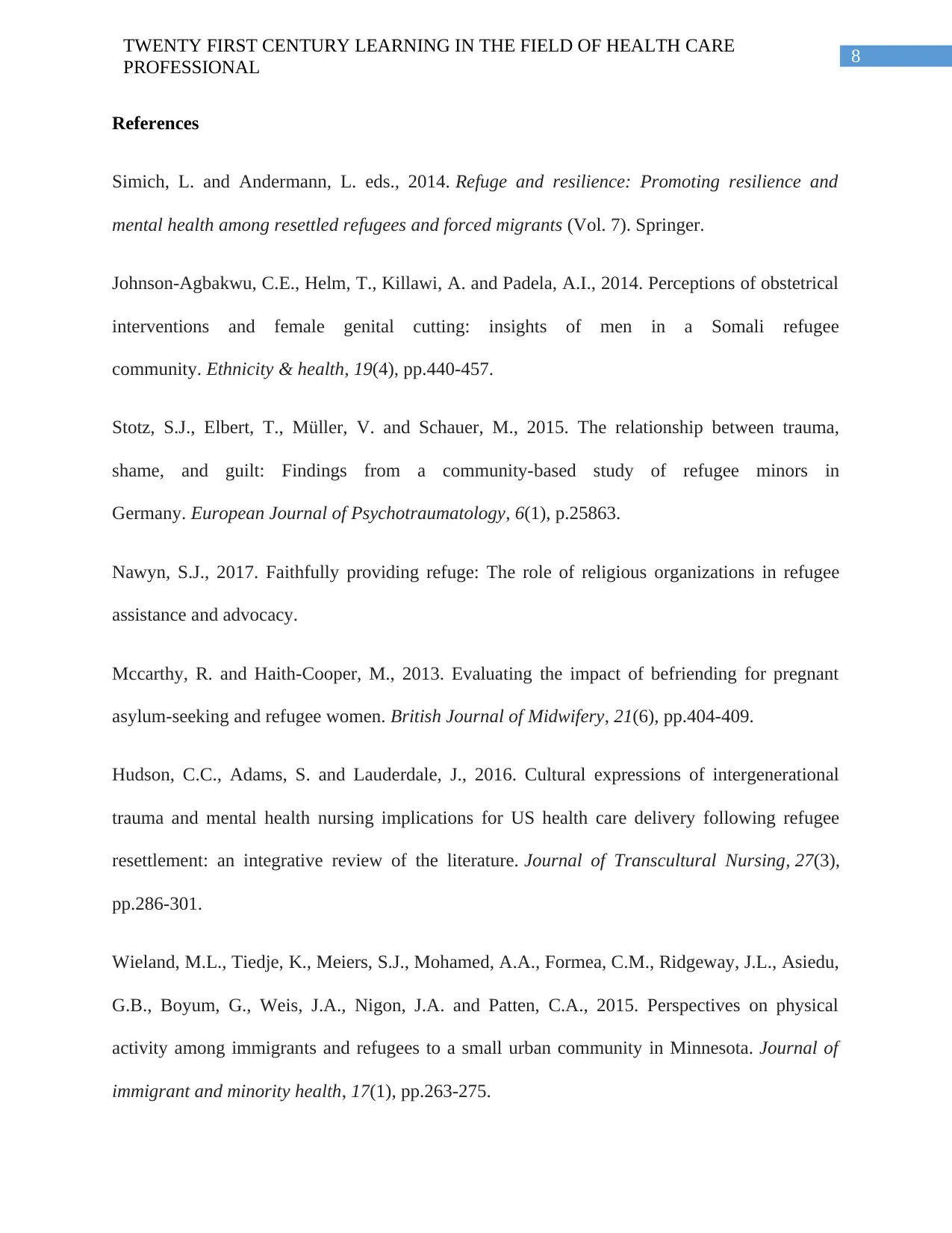
8
TWENTY FIRST CENTURY LEARNING IN THE FIELD OF HEALTH CARE
PROFESSIONAL
References
Simich, L. and Andermann, L. eds., 2014. Refuge and resilience: Promoting resilience and
mental health among resettled refugees and forced migrants (Vol. 7). Springer.
Johnson-Agbakwu, C.E., Helm, T., Killawi, A. and Padela, A.I., 2014. Perceptions of obstetrical
interventions and female genital cutting: insights of men in a Somali refugee
community. Ethnicity & health, 19(4), pp.440-457.
Stotz, S.J., Elbert, T., Müller, V. and Schauer, M., 2015. The relationship between trauma,
shame, and guilt: Findings from a community-based study of refugee minors in
Germany. European Journal of Psychotraumatology, 6(1), p.25863.
Nawyn, S.J., 2017. Faithfully providing refuge: The role of religious organizations in refugee
assistance and advocacy.
Mccarthy, R. and Haith-Cooper, M., 2013. Evaluating the impact of befriending for pregnant
asylum-seeking and refugee women. British Journal of Midwifery, 21(6), pp.404-409.
Hudson, C.C., Adams, S. and Lauderdale, J., 2016. Cultural expressions of intergenerational
trauma and mental health nursing implications for US health care delivery following refugee
resettlement: an integrative review of the literature. Journal of Transcultural Nursing, 27(3),
pp.286-301.
Wieland, M.L., Tiedje, K., Meiers, S.J., Mohamed, A.A., Formea, C.M., Ridgeway, J.L., Asiedu,
G.B., Boyum, G., Weis, J.A., Nigon, J.A. and Patten, C.A., 2015. Perspectives on physical
activity among immigrants and refugees to a small urban community in Minnesota. Journal of
immigrant and minority health, 17(1), pp.263-275.
TWENTY FIRST CENTURY LEARNING IN THE FIELD OF HEALTH CARE
PROFESSIONAL
References
Simich, L. and Andermann, L. eds., 2014. Refuge and resilience: Promoting resilience and
mental health among resettled refugees and forced migrants (Vol. 7). Springer.
Johnson-Agbakwu, C.E., Helm, T., Killawi, A. and Padela, A.I., 2014. Perceptions of obstetrical
interventions and female genital cutting: insights of men in a Somali refugee
community. Ethnicity & health, 19(4), pp.440-457.
Stotz, S.J., Elbert, T., Müller, V. and Schauer, M., 2015. The relationship between trauma,
shame, and guilt: Findings from a community-based study of refugee minors in
Germany. European Journal of Psychotraumatology, 6(1), p.25863.
Nawyn, S.J., 2017. Faithfully providing refuge: The role of religious organizations in refugee
assistance and advocacy.
Mccarthy, R. and Haith-Cooper, M., 2013. Evaluating the impact of befriending for pregnant
asylum-seeking and refugee women. British Journal of Midwifery, 21(6), pp.404-409.
Hudson, C.C., Adams, S. and Lauderdale, J., 2016. Cultural expressions of intergenerational
trauma and mental health nursing implications for US health care delivery following refugee
resettlement: an integrative review of the literature. Journal of Transcultural Nursing, 27(3),
pp.286-301.
Wieland, M.L., Tiedje, K., Meiers, S.J., Mohamed, A.A., Formea, C.M., Ridgeway, J.L., Asiedu,
G.B., Boyum, G., Weis, J.A., Nigon, J.A. and Patten, C.A., 2015. Perspectives on physical
activity among immigrants and refugees to a small urban community in Minnesota. Journal of
immigrant and minority health, 17(1), pp.263-275.
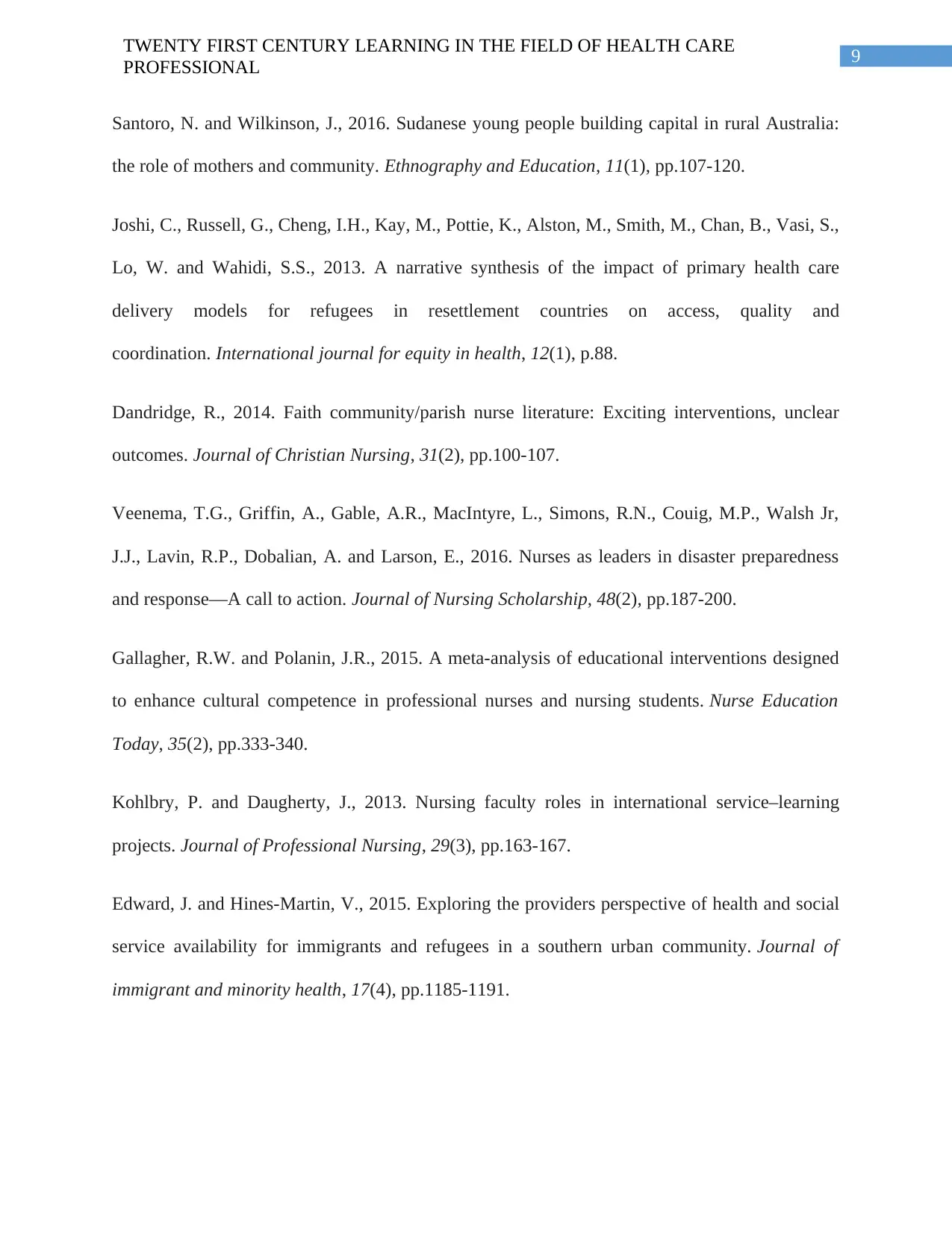
9
TWENTY FIRST CENTURY LEARNING IN THE FIELD OF HEALTH CARE
PROFESSIONAL
Santoro, N. and Wilkinson, J., 2016. Sudanese young people building capital in rural Australia:
the role of mothers and community. Ethnography and Education, 11(1), pp.107-120.
Joshi, C., Russell, G., Cheng, I.H., Kay, M., Pottie, K., Alston, M., Smith, M., Chan, B., Vasi, S.,
Lo, W. and Wahidi, S.S., 2013. A narrative synthesis of the impact of primary health care
delivery models for refugees in resettlement countries on access, quality and
coordination. International journal for equity in health, 12(1), p.88.
Dandridge, R., 2014. Faith community/parish nurse literature: Exciting interventions, unclear
outcomes. Journal of Christian Nursing, 31(2), pp.100-107.
Veenema, T.G., Griffin, A., Gable, A.R., MacIntyre, L., Simons, R.N., Couig, M.P., Walsh Jr,
J.J., Lavin, R.P., Dobalian, A. and Larson, E., 2016. Nurses as leaders in disaster preparedness
and response—A call to action. Journal of Nursing Scholarship, 48(2), pp.187-200.
Gallagher, R.W. and Polanin, J.R., 2015. A meta-analysis of educational interventions designed
to enhance cultural competence in professional nurses and nursing students. Nurse Education
Today, 35(2), pp.333-340.
Kohlbry, P. and Daugherty, J., 2013. Nursing faculty roles in international service–learning
projects. Journal of Professional Nursing, 29(3), pp.163-167.
Edward, J. and Hines-Martin, V., 2015. Exploring the providers perspective of health and social
service availability for immigrants and refugees in a southern urban community. Journal of
immigrant and minority health, 17(4), pp.1185-1191.
TWENTY FIRST CENTURY LEARNING IN THE FIELD OF HEALTH CARE
PROFESSIONAL
Santoro, N. and Wilkinson, J., 2016. Sudanese young people building capital in rural Australia:
the role of mothers and community. Ethnography and Education, 11(1), pp.107-120.
Joshi, C., Russell, G., Cheng, I.H., Kay, M., Pottie, K., Alston, M., Smith, M., Chan, B., Vasi, S.,
Lo, W. and Wahidi, S.S., 2013. A narrative synthesis of the impact of primary health care
delivery models for refugees in resettlement countries on access, quality and
coordination. International journal for equity in health, 12(1), p.88.
Dandridge, R., 2014. Faith community/parish nurse literature: Exciting interventions, unclear
outcomes. Journal of Christian Nursing, 31(2), pp.100-107.
Veenema, T.G., Griffin, A., Gable, A.R., MacIntyre, L., Simons, R.N., Couig, M.P., Walsh Jr,
J.J., Lavin, R.P., Dobalian, A. and Larson, E., 2016. Nurses as leaders in disaster preparedness
and response—A call to action. Journal of Nursing Scholarship, 48(2), pp.187-200.
Gallagher, R.W. and Polanin, J.R., 2015. A meta-analysis of educational interventions designed
to enhance cultural competence in professional nurses and nursing students. Nurse Education
Today, 35(2), pp.333-340.
Kohlbry, P. and Daugherty, J., 2013. Nursing faculty roles in international service–learning
projects. Journal of Professional Nursing, 29(3), pp.163-167.
Edward, J. and Hines-Martin, V., 2015. Exploring the providers perspective of health and social
service availability for immigrants and refugees in a southern urban community. Journal of
immigrant and minority health, 17(4), pp.1185-1191.
⊘ This is a preview!⊘
Do you want full access?
Subscribe today to unlock all pages.

Trusted by 1+ million students worldwide
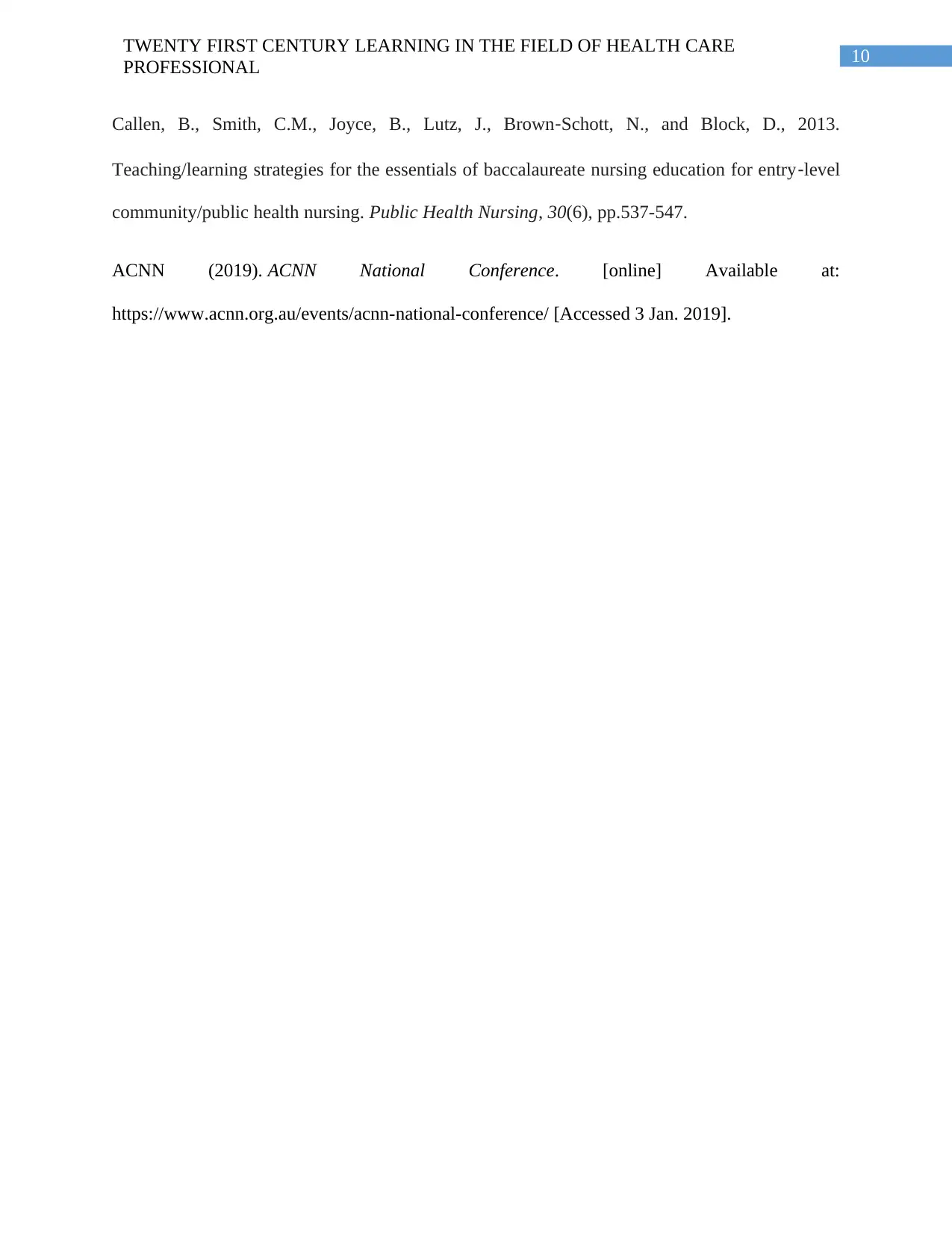
10
TWENTY FIRST CENTURY LEARNING IN THE FIELD OF HEALTH CARE
PROFESSIONAL
Callen, B., Smith, C.M., Joyce, B., Lutz, J., Brown‐Schott, N., and Block, D., 2013.
Teaching/learning strategies for the essentials of baccalaureate nursing education for entry‐level
community/public health nursing. Public Health Nursing, 30(6), pp.537-547.
ACNN (2019). ACNN National Conference. [online] Available at:
https://www.acnn.org.au/events/acnn-national-conference/ [Accessed 3 Jan. 2019].
TWENTY FIRST CENTURY LEARNING IN THE FIELD OF HEALTH CARE
PROFESSIONAL
Callen, B., Smith, C.M., Joyce, B., Lutz, J., Brown‐Schott, N., and Block, D., 2013.
Teaching/learning strategies for the essentials of baccalaureate nursing education for entry‐level
community/public health nursing. Public Health Nursing, 30(6), pp.537-547.
ACNN (2019). ACNN National Conference. [online] Available at:
https://www.acnn.org.au/events/acnn-national-conference/ [Accessed 3 Jan. 2019].
Paraphrase This Document
Need a fresh take? Get an instant paraphrase of this document with our AI Paraphraser
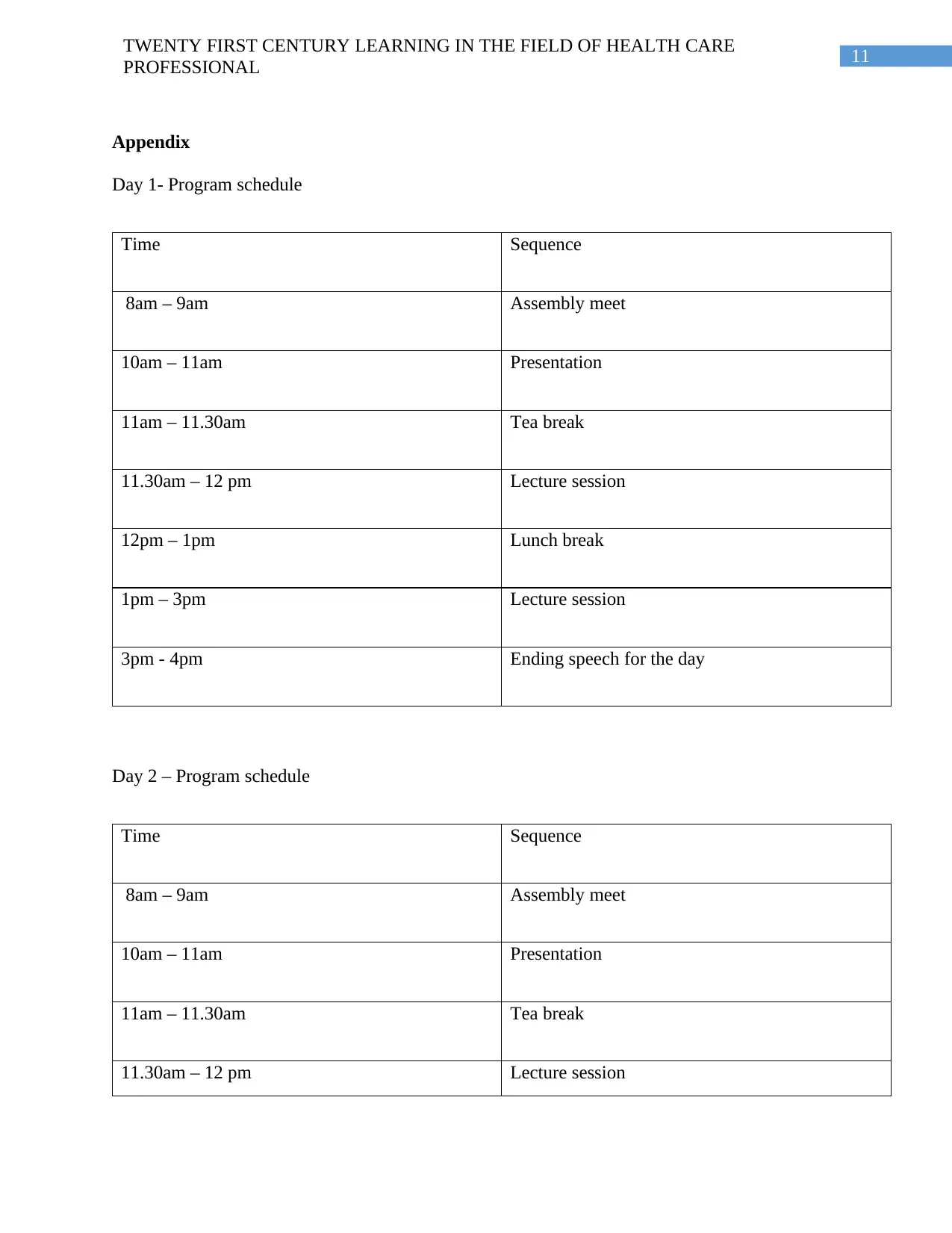
11
TWENTY FIRST CENTURY LEARNING IN THE FIELD OF HEALTH CARE
PROFESSIONAL
Appendix
Day 1- Program schedule
Time Sequence
8am – 9am Assembly meet
10am – 11am Presentation
11am – 11.30am Tea break
11.30am – 12 pm Lecture session
12pm – 1pm Lunch break
1pm – 3pm Lecture session
3pm - 4pm Ending speech for the day
Day 2 – Program schedule
Time Sequence
8am – 9am Assembly meet
10am – 11am Presentation
11am – 11.30am Tea break
11.30am – 12 pm Lecture session
TWENTY FIRST CENTURY LEARNING IN THE FIELD OF HEALTH CARE
PROFESSIONAL
Appendix
Day 1- Program schedule
Time Sequence
8am – 9am Assembly meet
10am – 11am Presentation
11am – 11.30am Tea break
11.30am – 12 pm Lecture session
12pm – 1pm Lunch break
1pm – 3pm Lecture session
3pm - 4pm Ending speech for the day
Day 2 – Program schedule
Time Sequence
8am – 9am Assembly meet
10am – 11am Presentation
11am – 11.30am Tea break
11.30am – 12 pm Lecture session
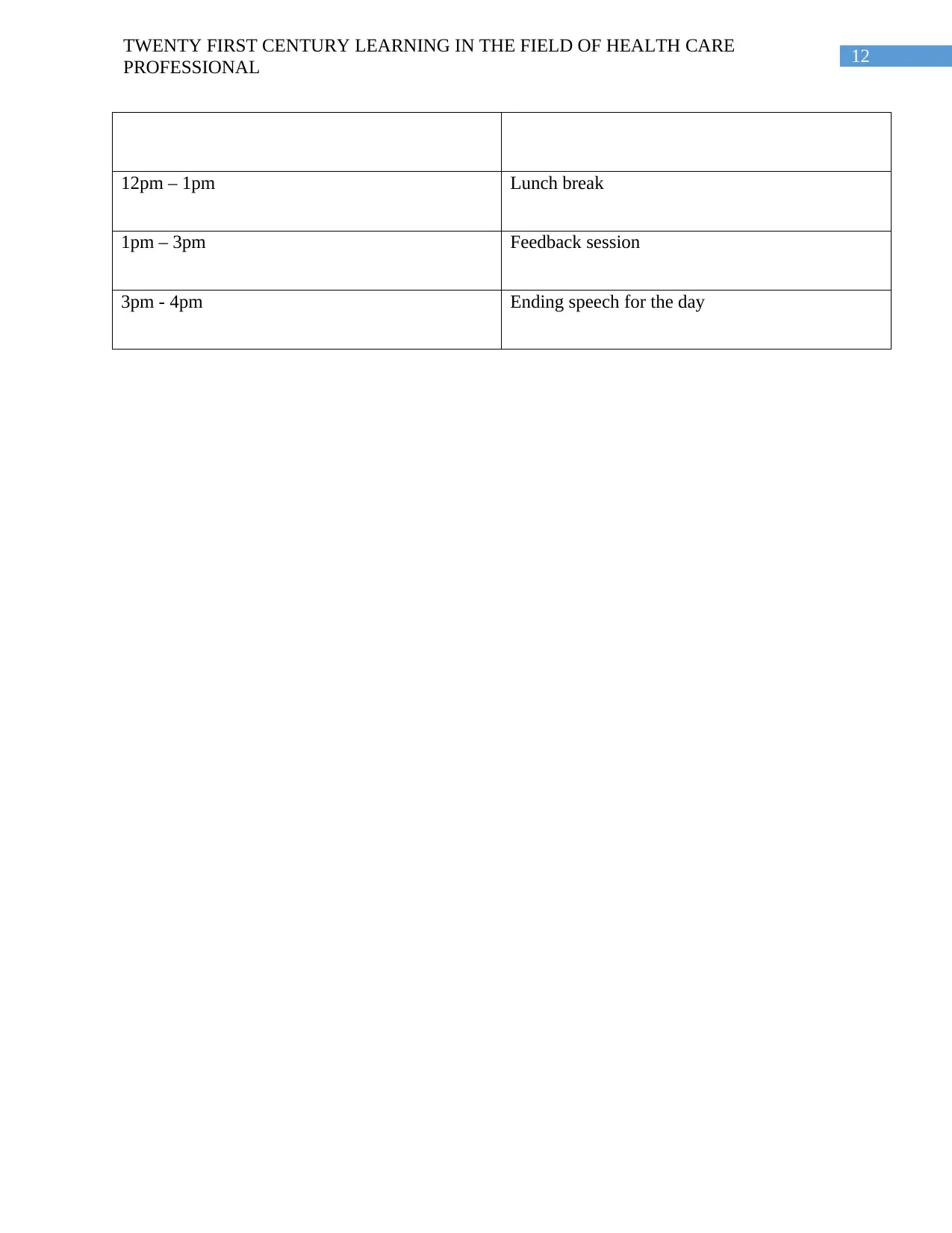
12
TWENTY FIRST CENTURY LEARNING IN THE FIELD OF HEALTH CARE
PROFESSIONAL
12pm – 1pm Lunch break
1pm – 3pm Feedback session
3pm - 4pm Ending speech for the day
TWENTY FIRST CENTURY LEARNING IN THE FIELD OF HEALTH CARE
PROFESSIONAL
12pm – 1pm Lunch break
1pm – 3pm Feedback session
3pm - 4pm Ending speech for the day
⊘ This is a preview!⊘
Do you want full access?
Subscribe today to unlock all pages.

Trusted by 1+ million students worldwide
1 out of 12
Related Documents
Your All-in-One AI-Powered Toolkit for Academic Success.
+13062052269
info@desklib.com
Available 24*7 on WhatsApp / Email
![[object Object]](/_next/static/media/star-bottom.7253800d.svg)
Unlock your academic potential
Copyright © 2020–2025 A2Z Services. All Rights Reserved. Developed and managed by ZUCOL.




